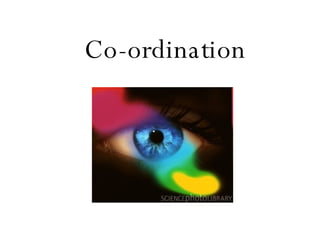Co Ordination
- 2. We have discovered how the digestive system , heart and lungs work together to provide the energy needed for muscle movement . What else do you need, to be able to move and respond to the environment around you?
- 3. All the organs and systems in a healthy human body work together to carry out functions essential to life. We need: Co-ordination ______ ______ To pick up information from our surroundings. ______ ______ _______ To process information received. Muscles, glands _________________ _________________ Notes
- 4. Structure of the Eye Cornea Pupil Iris Lens Retina Fovea Optic nerve Blind spot Vitreous humour
- 5. Structure of the Eye Label your copy of the eye. Using bullet points and highlighting the key structures: Describe the route light takes as it enters the eye, explaining the function of each structure it passes through. Cornea Pupil Iris Lens Retina Fovea Optic nerve Blind spot Notes
- 6. Optical Illusions Have a look at some of these visual phenomena. But not too long or you’ll feel sick!!! Activity
- 7. Pupil Size Dim Light Pupil dilates Bright Light Pupil contracts
- 8. Focusing Distant focus Close focus
- 9. Binocular Vision Notes -Stick in your copy of the diagram. -Use the text book to label and explain the diagram
- 10. middle ear bones Structure of the Ear outer ear (air filled) middle ear (air filled) inner ear (fluid filled) auditory canal hammer anvil stirrup semi-circular canals auditory nerve cochlea oval window ear drum
- 11. Hearing Judging the _____ of sound is more accurate using two ears rather than one. The ear collects _____ waves which are directed down the auditory canal to the ___ ____. This begins to _____ and the hammer, anvil and stirrup begin to move, transmitting sound waves towards the ___ ______ . The fluid in the _____ now starts moving, stimulating the sound ________ cells which send an impulse along the _______ ____ to the brain . Notes
- 12. Activity In pairs (you need a safety catcher!!): 1. Stand on one leg and count till you lose balance. How many seconds did you manage? 2. Stand on one leg again but this time with your eyes closed. Your friend can make sure you don’t fall over. How many seconds did you last this time? Why do you think this happened?
- 13. Balance - Semi circular canals Draw yourself a simple diagram like the heads to the left. Briefly describe how the semi-circular canals work to keep us balanced. Notes
- 14. The Nervous System Brain, spinal cord and nerve fibres communicating with sense organs, muscles, glands and internal organs
- 15. Copy and complete the diagram above. Notes The Flow of Information CNS C____ N____ S______ Includes: Sense organs have r____ : e.g. Effectors Bring about response e.g nerves nerves Help Success Guide p70
- 16. Nerve Cells (neurones) Sensory neurons Carry information from sense organs to CNS. Use the cut out sheet and the following slides to make your own diagrams and notes. Receptor Sensory fibre Axon fibre Cell body with nucleus Impulses to CNS Notes
- 17. Relay neurons Connect neurones. Receive information from sensory neurones and transmit to motor neurones. Impulses from sensory neurone Impulses to other neurones Cell body with nucleus Main relay fibre
- 18. Motor neurons Carry information from CNS to muscles and glands. Effector: Muscle or gland Cell body with nucleus Axon fibre Impulses from CNS
- 20. Neurones and the Reflex Arc Sensory neurone cell body Sensory Fibre Motor Fibre Response Nerve ending in receptor e.g in muscle CNS Synapse Motor neurone cell body Relay neurone cell body Stimulus Nerve ending in receptor e.g in skin
- 21. Reflex Arc Label your copy of the reflex arc. CNS Notes Help Torrance p169
- 22. The Reflex Action Motor neurone Spinal Cord Sensory neurone Motor neurone Relay neurone
- 23. Reflex action animation Using an example of your choice e.g heat, standing on a tac etc., describe how impulses are picked up and sent around the reflex arc. Should include: -order neurones passed through -receptor and effector -how the reflex action protects the body Notes Help Torrance p169 Success Guide p71
- 24. The Brain Skull Cerebrum Cerebellum Medulla Spinal cord Hypothalamus Pituitary gland
- 25. Cerebrum, cerebellum and medulla -Label your diagram of the brain -For each of the brain areas above, describe what they control. The Brain Notes
























